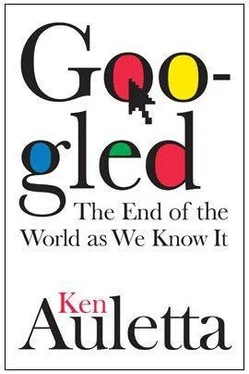A glance at the record company business suggests the depth of its travails. Into the nineties, best selling albums sold at least 15 million copies, said Jeffrey Cole of the Annenberg School ’s Center for the Digital Future at the University of Southern California. In 2007, the top-selling album registered only 3.7 million sales. People are listening to more music, but paying much less. Some performers, such as Madonna, bypass traditional music companies altogether. Following the predigital model of the Grateful Dead, who built their audience by encouraging fans to tape their performances, acts like Coldplay made single songs available for free over the Internet. (When released, Coldplay’s album Death and All His Friends shot to number one.) In 2007, worldwide digital music sales rose to 15 percent of all music sold, up from less than 1 percent in 2003. Yet this rise could not compensate for the decline of more expensive compact disc sales, which fell 10 percent that year. Music companies were in the business of selling albums, and since their sales peak in 2000 of nearly 800 million, album sales in 2007 plunged to just over 500 million. This helps explain why music company revenues have dropped significantly from $14.2 billion in 2000 and will dive to $9 billion by 2012, according to Forrester Research.
In one sense, newspapers share this dilemma. Most newspapers enjoy healthier profit margins than music companies, but these are shrinking. Investors punish their stocks because, compared with a Google or Apple, newspapers have dismal growth prospects. The speed with which the world of newspapering has changed was captured in interviews conducted by the Los Angeles Times Magazine with six former editors of the Los Angeles Times newspaper. William F. Thomas, the editor from 1971 to 1989, suggested that the so-called good old days were akin to what was commonplace at Google: “I never experienced any real restraints on anything we wanted to do for budget reasons… The only limit I recall was when they started enforcing a no-first-class rule.” By the time John S. Carroll took the helm in 2000, the newspaper’s corporate owners were seen as predators, people who understood math but not journalism, and Carroll, like his two successors, chose to quit in 2005 rather than obey directives from Chicago. With the benefit of hindsight, this fine editor blamed not just his former bosses, but himself as well. Carroll told the magazine that, like most editors, he was preoccupied with the fireman’s part of his job, answering news alarms, covering and editing daily stories. “If I had it to do over again, I might have taken some time off and tried to figure out where the Web was going and tried to do something about it.” This mistake-not to treat the arrival of the Internet with urgency, not to pour resources into a vibrant online newspaper-was one that most of his peers made as well.
In 2007, newspaper advertising, which accounts for about 80 percent of most U.S. newspaper revenue, fell 9.4 percent, according to the Newspaper Association of America. Adjusted for inflation, ad revenues were 20 percent lower than in their peak year, 2000. Circulation had dropped about 2 percent each year after 2003, and some papers, including the Los Angeles Times and the Boston Globe, lost about a third of their circulation in those years. The falloff in both advertising and newspaper sales would accelerate as more readers went online to sites like Google, Yahoo News, the Huffington Post, or Gawker.

The flight of advertisers from magazines was usually not nearly as severe, in part because advertisers believed they got more value from glossy, picture-filled pages. But even before the 2008 recession leveled magazines, many had slipped. Business magazines, said Time Inc. editor in chief John Huey, were battered by a severe drop in auto and tech advertising. Conde Nast would feel compelled to close Portfolio magazine in early 2009 and just months later Business Week was put up for sale. And the weekly news magazines, whose pages age rapidly in a time of instant news, were so bereft of advertising as to appear anorexic. U.S. News World Report at first announced that it would switch from a weekly to a biweekly publication schedule, then within months retreated further, saying it would only publish monthly.
It is true that if we add Web site visitors, newspapers and magazines had a net increase in readers. Twenty million unique visitors came each month in early 2008 to the largest newspaper Web site, the New York Times. The rub is that because the online audience pays less attention to ads and spends less time with an online newspaper, advertisers only pay 5 to 10 percent of what they do for the same ad in a newspaper. According to Jim Kennedy, vice president and director of strategic planning for the Associated Press, newspaper revenues in 2007 totaled sixty billion dollars, with online revenues accounting for only four billion of this total. Theoretically, a newspaper that abandoned print to publish online could save 60 to 80 percent of its overall costs, having done away with the expense of paper, printing, and distribution. To date, however, with the exception of the Wall Street Journal and the Financial Times, few if any daily newspapers have succeeded by charging for online subscriptions. With online newspapers generating minute advertising and zero circulation revenues-and with younger readers migrating online and exhibiting less loyalty to a particular news brand-newspapers that attempted to publish only online would undoubtably subtract more revenue than they would add.
Hemmed in, the print press in 2008 engaged in a blizzard of cost cutting. Newsweek shed two hundred jobs, Time Inc. six hundred; the San Jose Mercury News cleaved two hundred newsroom employees. The headcount at the world’s best newspaper, the New York Times, dropped almost 4 percent in a single year, and the McClatchy chain, which historically prided itself on its no-layoff policy, began laying off employees in September and by the spring of 2009 had reduced its workforce by 25 percent. After years of patching and pasting to get by, newspapers seemed to be in free fall. The Tribune Company cut five hundred weekly news pages in its papers and laid off employees, then filed for bankruptcy. The Philadelphia Inquirer and the Philadelphia Daily News would soon follow, as would others. The New York Times Company, with a bulge of debt payments due in the spring of 2009, sought a second mortgage on its headquarters building and accepted a $250 million loan at an inflated interest rate of 14 percent from Mexican billionaire Carlos Slim. The Christian Science Monitor shut down its daily print edition and went online, as would the Seattle Post-Intelligencer. Gannett, the nation’s largest newspaper publisher with eighty-five dailies, watched its stock price drop 87 percent in a twelve-month period.
Not everyone in the news businesses was on a starvation diet. Three wire services-the AP, Reuters, and Bloomberg-defied the industry trend. There were several reasons for this. The bleak economic climate for newspapers, ironically, benefited the wire services. As newspapers contracted, they outsourced more of their news gathering to the wire services. (“The cold our customers caught,” said Thomson Reuters CEO, Thomas Glocer, “has been good for Reuters-unless the patient dies! That would be bad for Reuters.”) And unlike most newspapers, the wire services moved early to tap new sources of revenue. The AP, according to its CEO, Tom Curley, “gets about 20 percent of our revenues from digital sources.” The AP’s 2008 revenues totaled $750 million, which means digital sources-Google News and Yahoo and advertising from newspaper and broadcast links and other customers-generated about $150 million. And broadcasting revenues were even larger. More than half the AP’s worldwide revenues now came not from the fees newspapers paid but from its broadcast and online operations.
Читать дальше











